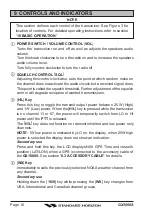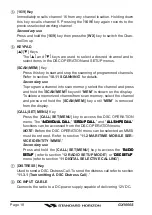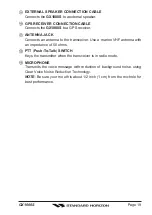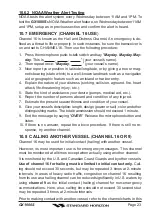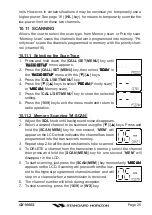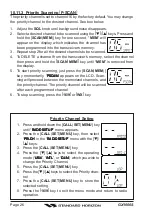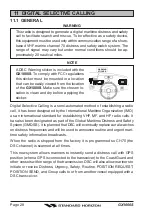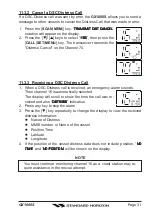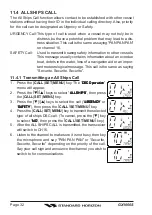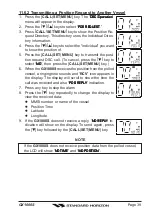
GX1000S
Page 24
manual, and select an appropriate channel for communications after initial
contact. For example, Channels 68 and 69 are some of the channels available
to non-commercial (recreational) boaters. Monitor your desired channel in ad-
vance to make sure you will not be interrupting other traffic, and then go back
to either channel 16 or 9 for your initial contact.
When the hailing channel (16 or 9) is clear, state the name of the other vessel
you wish to call and then “
this is
” followed by the name of your vessel and
your Station License (Call Sign). When the other vessel returns your call, im-
mediately request another channel by saying “
go to
,” the number of the other
channel, and “over.” Then switch to the new channel. When the new channel
is not busy, call the other vessel.
After a transmission, say “
over
,” and release the microphone’s push-to-talk
(
PTT
) switch. When all communication with the other vessel is completed, end
the last transmission by stating your Call Sign and the word “
out
.” Note that it
is not necessary to state your Call Sign with each transmission, only at the
beginning and end of the contact.
Remember to return to Channel 16 when not using another channel. Some
radios automatically monitor Channel 16 even when set to other channels or
when scanning.
10.9 MAKING TELEPHONE CALLS
To make a radiotelephone call, use a channel designated for this purpose, The
fastest way to learn which channels are used for radiotelephone traffic is to
ask at a local marina. Channels available for such traffic are designated
Pub-
lic Correspondence
channels on the channel charts in this manual. Some
examples for USA use are Channels 24, 25, 26, 27, 28, 84, 85, 86, and 87.
Call the marine operator and identify yourself by your vessel’s name, The marine
operator will then ask you how you will pay for the call (telephone credit card,
collect, etc.) and then link your radio transmission to the telephone lines.
The marine telephone company managing the VHF channel you are using
may charge a link-up fee in addition to the cost of the call.
10.10 OPERATING ON CHANNELS 13 AND 67
Channel 13 is used at docks and bridges and by vessels maneuvering in port.
Messages on this channel must concern navigation only, such as meeting and
passing in restricted waters.
Channel 67 is used for navigational traffic between vessels.
By regulation, power is normally limited to 1 Watt on these channels. Your
radio is programmed to automatically reduce power to this limit on these chan-
Содержание Eclipes DSC GX1000S
Страница 17: ...Page 17 GX1000S Figure 3 Controls and Connectors ...
Страница 58: ...GX1000S Page 58 16 4 GX1000S DIMENSIONS ...
Страница 59: ...Page 59 GX1000S MEMO ...







